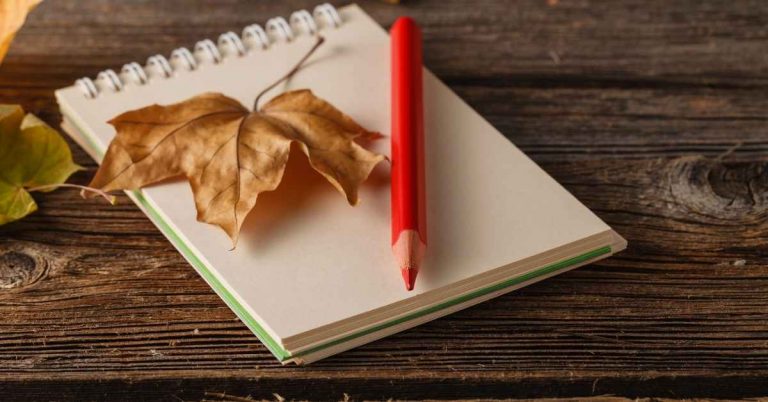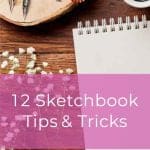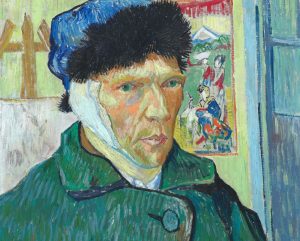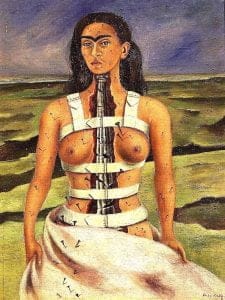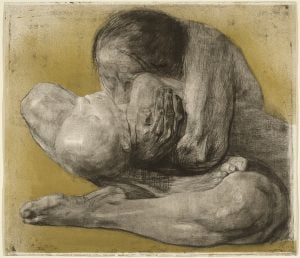Last Updated on April 11, 2023 by Dee
Looking for some sketchbook tips & tricks to get your sketchbook skills up to scratch?
An artists’ sketchbook is a great tool to have! They are also often called art journals, visual diaries or artist books, and are used for many different creative purposes.
An art student would use their sketchbook to develop ideas and hone their drawing skills. An interior decorator would use one to plan out furniture positioning and décor ideas, or a fashion designer might use one to sketch out designs for apparel and footwear.
Or maybe you’re like me and you like to keep a sketchbook so you can spend time sketching and developing your drawing skills and imagining new art ideas.
Your sketchbook can become your own personal, private art journal where you express your most intimate thoughts and deepest feelings.
A sketchbook can become a tool for inner healing and reflection on the events in your daily life.
There are so many benefits to keeping a sketchbook. Personally, I find that it helps me decompress and destress after a long working week – and I always come away feeling motivated to draw more!
So, if you need some tips and tricks to take your artists’ sketchbook to the next level have a browse through my list of 12 tips and tricks below!
12 Essential Sketchbook Tips and Tricks
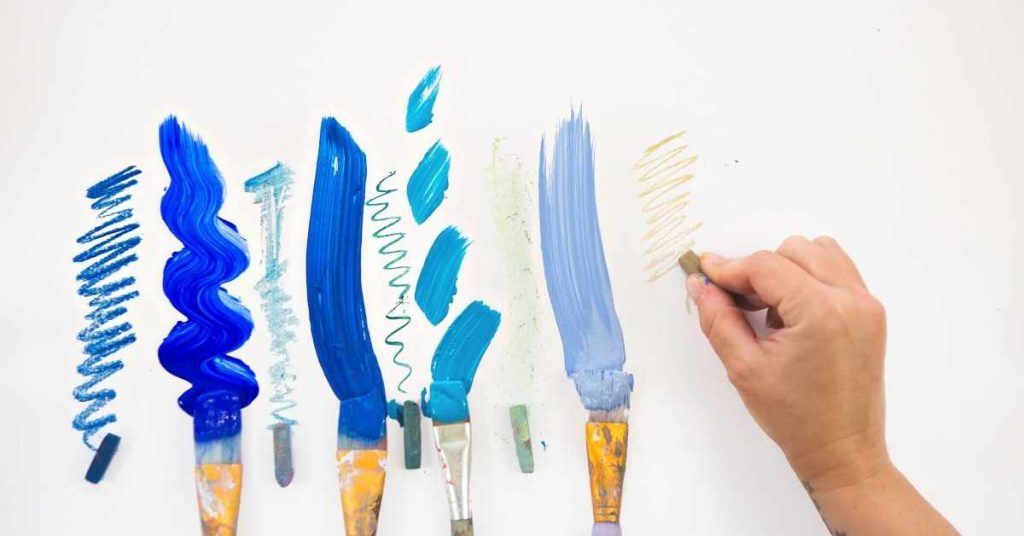
Work from observation
If you want to improve your drawing and sketch subject matter that looks real then you need to spend time observe the real thing.
Don’t get me wrong, its pretty liberating drawing from your imagination, but often our brain leaves out important information about the subject we are drawing. It’s a proven fact that drawing from observation helps you sketch your subject matter with more realism and accuracy.
Don’t give up!
Attitude is everything! If you want to improve your drawing you have to keep trying. Even the great art masters messed up their artworks once in a while. And you know what? They kept trying! Drawing is a skill that can be improved with practice! Keep practicing and don’t give up.
Use good reference photos
Its always a good idea to make sure you are working from photos that are clear and not pixelated! If you want to draw something accurately you need to make sure you can see where objects begin and end.
A poorly photocopied image or a low-quality pic on your phone just aren’t going to give you the results you need!
[Related article: 59 Aesthetic Things to Draw: Art Ideas for Creative Minds]
Use fixative (or hairspray)
Nothing worse than leaning over your art to reach for something and realizing that you have smudged your drawing!
If you are drawing with charcoal, pencil or pastel you should spray fixative on your drawing once you are finished. This holds or fixes the medium to the paper so that it doesn’t get smudged.
Play
Explore your mediums. Try out different and unusual mediums like painting with coffee or Gel plate printing.
[Related article: How to Improve Your Digital Creations | 22 Digital Painting Tips]
Explore your materials. Collect a variety of textured and patterned paper, tear it up and collage it in your sketchbook – and then having fun drawing over it.
In fact, this is one of the best ways to start a new sketchbook page – your not staring at a blank, white page and there is already something to work with.
Explore your tools. Test out different tools that you have tried before. Have you tried working with glass dipping pens and India ink to create line drawings? What about different gel pens or water-soluble crayons?
The most important thing about a sketchbook is that it should be fun and a place to explore.
[Related article: How to Draw a Background]
Be consistent
As with anything in life the more regularly you do something, the better you get. Try to set regular time to work in your sketchbook.
If you can’t commit to daily doodling, then try for 15 minutes one day a week and make that your special creative time where you can go into your head and enjoy the art-making process.
Think outside the box
When you first start a sketchbook, you may find that you run out of exciting drawing ideas!
During the day look for inspiration in the world around you and make a note of what inspires you and attracts you.
Perhaps there was a cool design on a takeaway coffee cup, or a beautiful old tree in the park. If you start looking at the world with new eyes you will find that there are so many things you can draw.
You can also start a daily or monthly art challenge and use art prompts to get your ideas flowing.
[Related Article: Art Challenges]
Here are some art prompt ideas to get your creative juices flowing:
- Nature
- Home
- Connection
- My favorite song
- I miss…
- I wish for…
- The most delicious thing
- Opposites
- Read between the lines
- A quote
Turn mistakes into art
In art there are no mistakes, only opportunities for growth. Mistakes are part of the beauty of art and often it is these happy accidents that help us grow and develop our artistic skills.
So, how do you fix a ruined sketchbook page?
Use your creative problem solving to turn a mistake into something else.
Spilt tea over your drawing? Use it to create an interesting background.
Realized that your figures proportions are way out? Emphasize your elongated proportions to create a dream-like figure.
And remember layering is your friend. If there is an area on your sketchbook page that is just not working, you can stick interesting paper or material over the problem spot!
By adding new materials and different textures to your sketchbook you can create a beautiful aesthetic and a really interesting final effect.
Make it personal
If you really want to make beautiful art and render powerful drawings you should make it personal.
Use ideas, objects, landscapes, people and animals that have meaning in your own life.
[Related article: 50 Easy Things to Draw on Your Hand]
The things that cause us the most pain and the most joy in life, are usually the catalysts for the most powerful art.
Think about some of the most famous paintings and artworks in history – they were all inspired by some deeply emotional link.
Van Gogh painted his self-portrait with bandaged ear shortly after he came home after being in hospital for cutting off his ear. He was in a heightened state of anxiety and depression and he was very much out of touch with reality.
Frida Kahlo’s ,The Broken Column, was a painting about the after-effects of a horrific bus accident that she was in.
Kathe Kollwitz painted the grieving mothers she witnessed during the traumas of the two world wars.
These paintings are examples of how out of our personal pain, powerful art can be created.
Annotate
Writing down your thoughts and ideas in your sketchbook is a really important thing to do. Sometimes your sketches and artwork won’t tell you everything you need to know about an idea, technique or art-making process and so adding written text helps to get all the information down.
You can go back and read over your notes and comments to reflect on what you enjoyed or didn’t enjoy, what your inspiration was and what you were feeling at the time.
These annotations can become a springboard for new exciting and creative art ideas.
Here are some ideas for sketchbook annotations:
- What inspired your drawing today?
- What emotions are you feeling in the moment?
- What medium are you working with?
- What medium would you like to try?
- What do you find challenging about this drawing?
- What are you enjoying about this sketch?
- What style are you working in?
- Write down a quote or song lyrics linked to the emotion you are feeling.
- Make a list of art materials.
- Write the date.
- Write down websites and artists that have inspired you.
Use color
Often when we visualize a sketchbook, we think of graphite pencil on white paper. This is very limiting and doesn’t have to be the case.
Explore using different colors in different combinations to create interesting sketchbook pages.
You can have even apply a color theme for the day. If you are feeling blue – fill your page with cool colors. If you are happy about something use joyful colors to accent your artwork.
[Related Article: Why you need a travel sketchbook!]
Conclusion
Rinse and repeat these sketchbook tips and tricks to get the most out of your sketchbook. If you would like more drawing tips read my article on How to improve your drawing.
Other articles you may enjoy…
How to Improve Your Digital Creations | 22 Digital Painting Tips
Looking For a Mixed Media Sketchbook? 16 Best Mixed Media Sketchbooks for Wet & Dry Media

